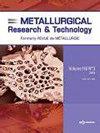不同研磨顺序对DC06与等厚热冲压B1500HS钢板异种电阻点焊接头力学性能及熔核形成过程的影响
IF 0.9
4区 材料科学
Q3 METALLURGY & METALLURGICAL ENGINEERING
引用次数: 0
摘要
在本研究中,两个焊接接头在不同研磨顺序下的力学性能(B1500HS-1.4 mm/B1500HS-1.6 mm/DC06,记为I型;B1500HS-1.4 mm/DC06/B1500HS-1.6 mm(表示II型)进行比较。采用电-热耦合有限元模型对熔核形成机理进行了分析。研究发现,不同的研磨顺序对三片RSW接头的力学性能有显著影响。所有RSW接头都倾向于以拔出或撕裂破坏模式失效。II型RSW接头的两个界面峰值荷载更为平衡,其破坏荷载远高于I型RSW接头;在I型焊接接头处观察到翘曲现象。考虑到承载能力,II型是优秀的。仿真结果表明,ⅰ型RSW接头上界面处焊缝熔核直径大于其他界面处,与实验结果吻合较好。得到了异种高强钢三片RSW接头的熔核形成机制:先从两个界面形成熔核,最终形成的熔核是非对称的。本文章由计算机程序翻译,如有差异,请以英文原文为准。
Effect of different lapping orders on mechanical performance and nugget forming process for three-sheet dissimilar resistance spot welding joints between DC06 and unequal-thickness hot-stamped B1500HS steel sheets
In this study, the mechanical properties of two welded joints under different lapping orders (B1500HS-1.4 mm/B1500HS-1.6 mm/DC06, denoted as type I; B1500HS-1.4 mm/DC06/B1500HS-1.6 mm, denoted type II) were compared. The nugget formation mechanism was analysed by a coupled electrical-thermal finite element model (FEM). It is found that different lapping orders significantly affect the mechanical properties of three-sheet RSW joints. All RSW joints tend to fail in the pull-out or tearing failure mode. The peak load of the two interfaces of type II RSW joint is more balanced, and the failure load of which is much higher than that of the type I RSW joint; The warpage was observed at type I welded joint. Considered the load-carrying capacity, type II was excellent. The simulation results indicate that the diameter of the weld nugget at the upper interface of the type I RSW joint was larger than that on the other interfaces, which agree well with the experimental results. The nugget formation mechanism of dissimilar high strength steel three-sheet RSW joint was obtained that forming the nugget firstly from two interfaces and final formed nuggets were asymmetric.
求助全文
通过发布文献求助,成功后即可免费获取论文全文。
去求助
来源期刊

Metallurgical Research & Technology
METALLURGY & METALLURGICAL ENGINEERING-
CiteScore
1.70
自引率
9.10%
发文量
65
审稿时长
4.4 months
期刊介绍:
Metallurgical Research and Technology (MRT) is a peer-reviewed bi-monthly journal publishing original high-quality research papers in areas ranging from process metallurgy to metal product properties and applications of ferrous and non-ferrous metals and alloys, including light-metals. It covers also the materials involved in the metal processing as ores, refractories and slags.
The journal is listed in the citation index Web of Science and has an Impact Factor.
It is highly concerned by the technological innovation as a support of the metallurgical industry at a time when it has to tackle severe challenges like energy, raw materials, sustainability, environment... Strengthening and enhancing the dialogue between science and industry is at the heart of the scope of MRT. This is why it welcomes manuscripts focusing on industrial practice, as well as basic metallurgical knowledge or review articles.
 求助内容:
求助内容: 应助结果提醒方式:
应助结果提醒方式:


